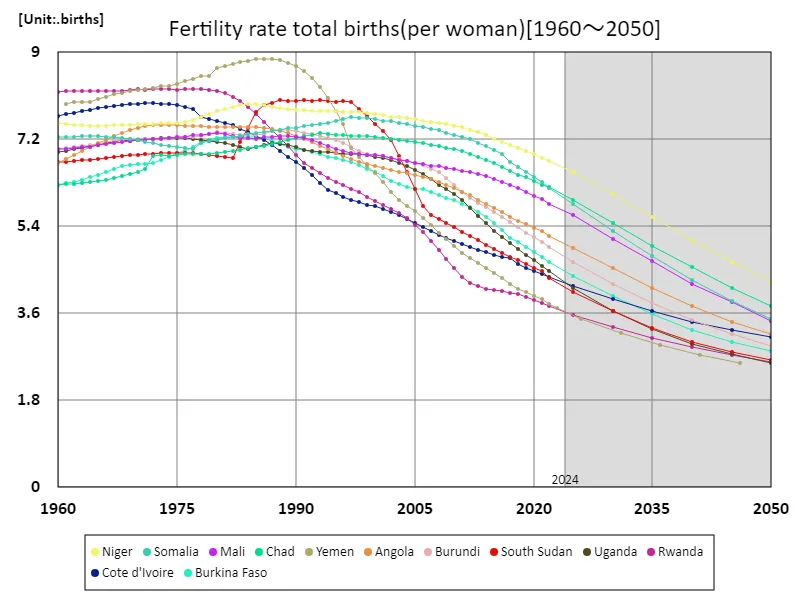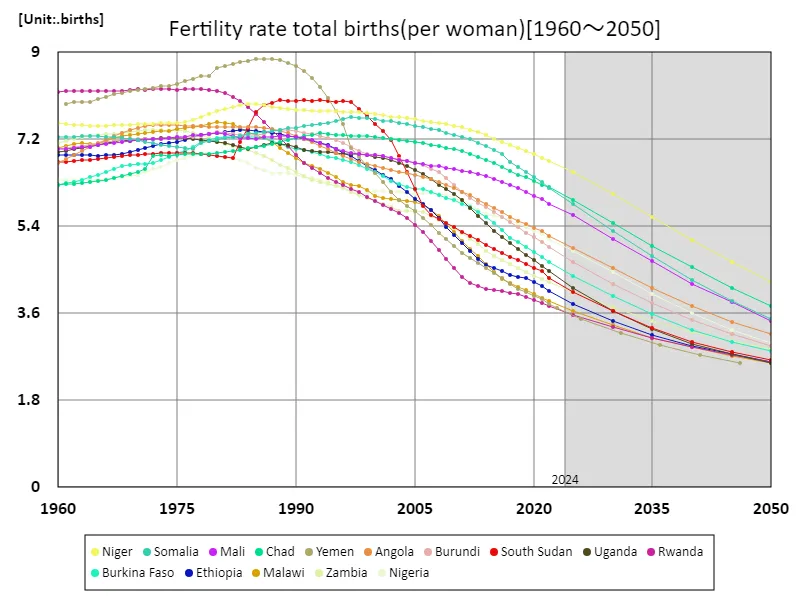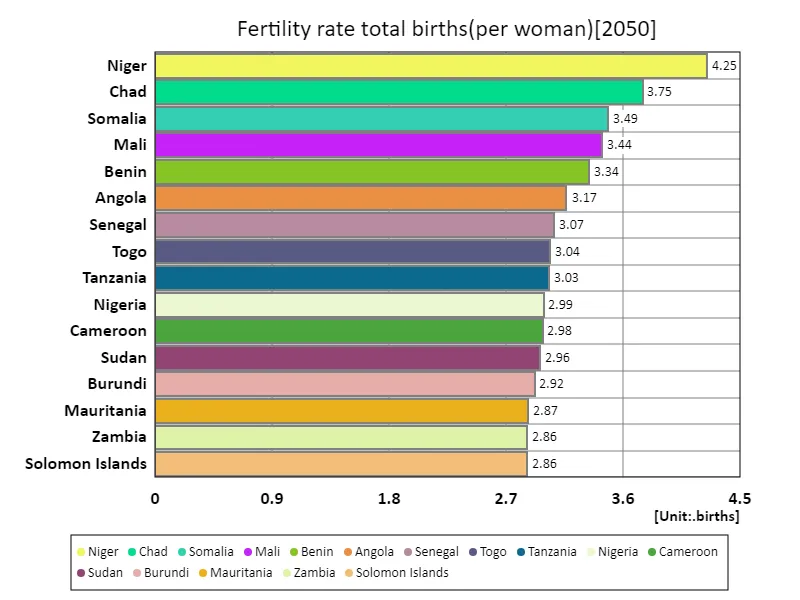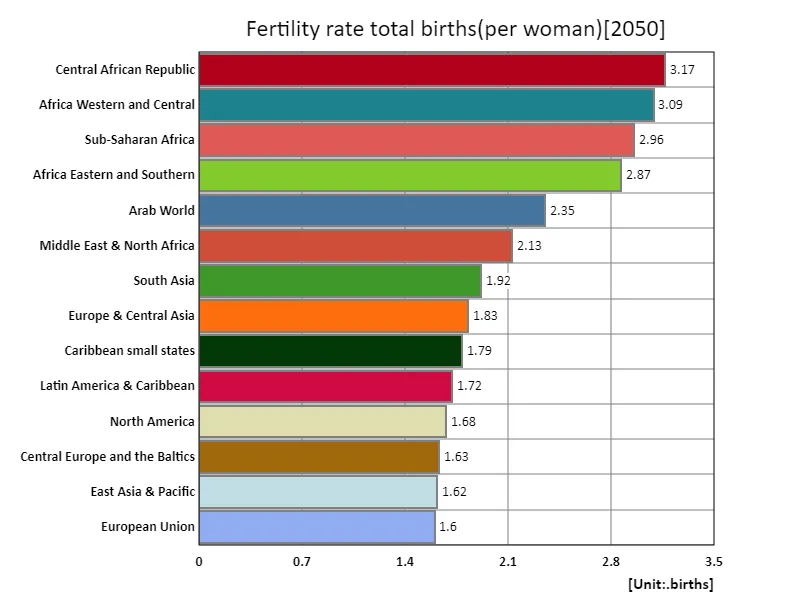Abstract
Total births (per woman) is an important indicator in global economic and demographic trends. African countries in particular have high birth rates. Niger, for example, is projected to have a total birth rate of 4.25 in 2050, the highest in the world. This reflects the country’s high birth rate and young population. Over the past few decades, African countries have maintained relatively high birth rates, which has been the main driver of population growth. On the other hand, birth rates are declining in developed countries, and population decline and aging are becoming problems. Africa’s high birth rate is due to factors such as the spread of education, improved medical care, and economic development, but the rapid population growth also puts strain on resources and makes it difficult to develop social infrastructure. Looking to the future, demographic changes will have a major impact on regional economic strategies. In particular, areas with high birth rates need policies that aim for sustainable development.
Total births (per woman)
Changes in fertility rates have profound effects on economies and societies around the world. Yemen is a notable example of a dramatic shift in total birth numbers between 1960 and 2050. In 1986, Yemen recorded a high birth rate of 8.86 total births, but the birth rate has declined sharply since then and currently stands at 28.9% of its peak. The main factors behind this are the spread of education, women’s advancement in society, improvements in medical care, and economic growth. Globally, many countries are experiencing a transition from high to low fertility rates, especially in developing countries. In countries that have passed the peak of their high birth rates, population growth has slowed along with economic development, and in developed countries, declining birth rates have become a social issue. Falling birth rates lead to a shrinking workforce and an ageing society, posing economic challenges. Falling birth rates have countries exploring policies and strategies to adapt to changing labour markets, and sustainable development requires economic policies that take demographic change into account.


The maximum is 8.86births[1986] of Yemen, and the current value is about 28.9%
Total births (per woman) (worldwide)
Fluctuations in total fertility (per woman) reflect changes in the global economy and society. Data from 1960 to 2050 show that in 1986, Yemen recorded a high of 8.86 total births, but is currently at just 28.9% of that peak. This dramatic decline reflects the success of improved education, improved health care, economic development, and family planning policies. Globally, birth rates have been declining for the past few decades. In developing countries in particular, it is common for birth rates to decline along with economic growth. The example of Yemen also shows that a steep decline in fertility has accompanied socio-economic change in the country. On the other hand, developed countries are already facing low birth rates, labor shortages and aging societies, putting increasing pressure on social security systems. Thus, fluctuations in fertility rates reflect the stage of economic and social development and require country-specific policy responses. Achieving a balance between economic growth and demographic trends has become a key challenge for sustainable development.


The maximum is 8.86births[1986] of Yemen, and the current value is about 28.9%
Total births (per woman) (world country, latest year)
The data on total fertility (per woman) for 2050 highlights the world’s demographic and economic challenges. Niger recorded the highest fertility rate at 4.25, which remains a high fertility rate. In comparison, the global average is 2 births, with the total number of births being 374. This figure shows that birth rates are declining around the world. Over the past few decades, there has been a noticeable decline in birth rates worldwide. In developed countries in particular, birth rates are declining due to economic development, improving living standards, and the spread of education. Conversely, developing countries often still experience high fertility rates, and Niger is a classic example. This high birth rate is due to the still high proportion of young people and insufficient development in education and medical care. Differences in birth rates have a significant impact on each country’s economy and social structure. Countries with high birth rates need to develop infrastructure and social services to cope with rapid population growth. On the other hand, countries with low birth rates face challenges such as labor shortages and aging populations, and need immigration policies and productivity improvement measures to achieve sustainable economic growth. In this way, fluctuations in birth rates are deeply connected to each country’s economic strategy and are an important factor in shaping the future structure of society.


The maximum is 4.25births of Niger, the average is 2births, and the total is 371births
Total births (per woman) (region, latest year)
According to data for 2050, the Central African Republic will have the highest total births (per woman) at 3.17, compared to the global average of 2.13 and a total of 32. These figures show that changes in fertility and life expectancy affect different regions differently. Over the past few decades, global fertility rates have been generally declining. In developed countries, the spread of education, women’s participation in society, and economic stability have led to declining birth rates, which are now below two in many countries. In contrast, developing countries like the Central African Republic continue to have high birth rates. The reasons for this include a lack of educational and medical infrastructure, traditional family values, and a high proportion of young people. Increased life expectancy is also affecting fertility rates. While life expectancy is increasing in many countries, declining birth rates are changing the demographic structure and leading to an ageing society. Labor shortages and pressure on social security systems are becoming problems, especially in countries with low birth rates. Overall, fluctuations in fertility rates have a significant impact on countries’ economic growth and social policies, and sustainable development requires striking a balance between fertility and life expectancy.


The maximum is 3.17births of Central African Republic, the average is 2.13births, and the total is 32births



Comments